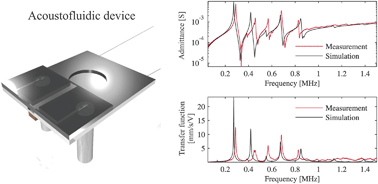Because of uncertainties in material and geometrical parameters in ultrasonic devices, experimental characterization is an indispensable part in their successful application for the manipulation of particles or cells. Its miniaturized size precludes the use of many of the usual tools used for macroscopic systems. Also, a further challenge is the fact that the resulting motion due to the electromechanical actuation has both high frequency and small amplitudes. Contactless methods like laser interferometry are therefore promising methods. In addition, as long as there is strong electromechanical coupling between the transducer and the device also electrical measurements like admittance curves give insight into the frequencies at which the devices might work best. This is the case for example for piezoelectric transducers working at one of their resonance frequencies. Because the devices usually are used in resonant modes, narrow frequency detection methods like lock in amplifiers help to improve the signal to noise ratio. Also many analysis tools have been established in the context of modal analysis, which is based on frequency domain methods. Special emphasis is placed here on the determination of the quality factor Q of the resonator, as Q determines the efficiency of a device.
